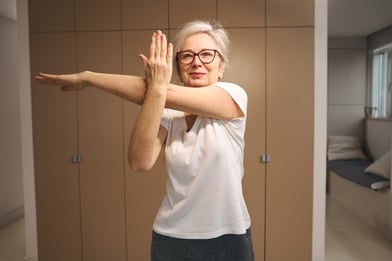 Anyone and everyone can benefit from having better balance. From professional athletes to the active aging population, balance plays a critical role in everyday life. Whether a professional gymnast is flipping on a beam, or a senior is simply trying to lower their risk of falling, improving balance starts with two things: identifying muscle imbalances and follows up with corrective exercise. The skeleton is put together in a way that encourages a steady base and equal weight distribution. This allows a person’s center of gravity to be right around the belly button. If a person has no muscle imbalances, their weight and center of gravity would be sitting directly above the pelvis. The hip bone then distributes that weight to each of the legs. In a perfect world that would mean the person’s knees would be directly below the hip joint and the ankle would be straight below the knee joint. The perfect world hardly exists, and muscle imbalances are the reason.
Anyone and everyone can benefit from having better balance. From professional athletes to the active aging population, balance plays a critical role in everyday life. Whether a professional gymnast is flipping on a beam, or a senior is simply trying to lower their risk of falling, improving balance starts with two things: identifying muscle imbalances and follows up with corrective exercise. The skeleton is put together in a way that encourages a steady base and equal weight distribution. This allows a person’s center of gravity to be right around the belly button. If a person has no muscle imbalances, their weight and center of gravity would be sitting directly above the pelvis. The hip bone then distributes that weight to each of the legs. In a perfect world that would mean the person’s knees would be directly below the hip joint and the ankle would be straight below the knee joint. The perfect world hardly exists, and muscle imbalances are the reason.
Every moving joint has a muscle origin point on either side of it. For example, the shoulder joint holds the origin points of the biceps brachii and triceps brachii muscles. If the biceps muscle is stronger or tighter than the triceps muscle, the shoulder joint will be pulled and rotated forward. Any muscle imbalance will cause a change in mass distribution, ultimately resulting in a new center of mass. The body will compensate for this by changing gait or shifting other joints into a position that will feel stable. Unfortunately, this new position is usually one that the joint is not meant to be in. Until the initial imbalances are corrected through training, more imbalances will occur. The longer someone waits to begin corrective exercise, the harder it will be to correct, and the likelihood of injury or sustained damage will increase.
When the skeleton is completely in balance, all the joints are aligned, and the body is in its most stable position. Recognizing these imbalances are important, especially with the active aging community. The most common shifts in the skeleton are:
- Anterior Pelvic Tilt (when the pelvis is rotated forward)
- Excessive Kyphotic Posture (rounded back/shoulders)
- Internal Rotation of the Shoulders (which can cause shoulder injury)
And all these deviations will not only cause pain, but a shift in someone’s center of balance. Being mindful of these imbalances and working on correcting them as soon as possible are very important. Corrective exercise will allow someone to achieve better balance while also relieving the pain caused by the skeletal shifts. With every muscle imbalance, there is a tight muscle and a weak antagonist muscle. Both issues should simultaneously be worked on to correct the imbalance.
Ways of releasing the tight muscle temporarily include:
- Soft Tissue Massage
- Foam Rolling
- Stretching
Ways of strengthening the weak muscle for long term correction include:
- Moving the Joint
- Isolation Exercises
- Isometric Contractions
Including any combination of these in an exercise program will help alleviate those muscle imbalances, providing pain relief and better balance. Consider scheduling an assessment with a fitness professional to have these possible imbalances identified and exercise prescribed to help!

